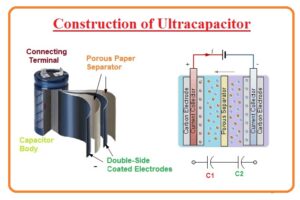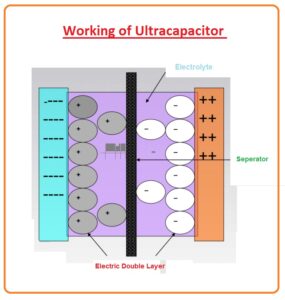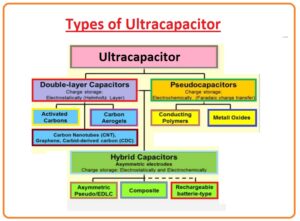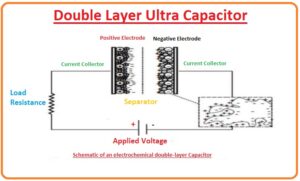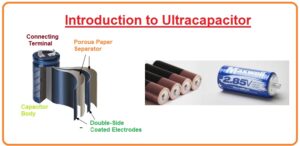 Hi, readers welcome to the new post. In this post, we will have a detailed look at Introduction to Ultracapacitor. An ultracapacitor is an energy-storing component that stores a large number of charges. The capacitor is the simplest device that consults of two matte lip plates and insulating material between them which is also known as the dielectric material. Capacitors stock energy in the shape of the electric field because of their capability to accumulate charge. Storage of charge depends on the applied voltage to the capacitor. Storage charge is directly proportional to the applied voltage.
Hi, readers welcome to the new post. In this post, we will have a detailed look at Introduction to Ultracapacitor. An ultracapacitor is an energy-storing component that stores a large number of charges. The capacitor is the simplest device that consults of two matte lip plates and insulating material between them which is also known as the dielectric material. Capacitors stock energy in the shape of the electric field because of their capability to accumulate charge. Storage of charge depends on the applied voltage to the capacitor. Storage charge is directly proportional to the applied voltage.
An ultracapacitor is a special type of capacitor manufactured to stored a larger charge due to this its plate size is large and the distance between them is small. A normal capacitor uses solid insulating material but an ultracapacitor used a liquid dielectric substance which makes it an electrochemical component.
Though it is a category of electrochemical expedient, there is no chemical reaction that occurs in it to store of charge.
Introduction to ultracapacitor
- The ultracapacitor is also named a super-capacitor. The enterprise and phenomena of the procedure is among a normal capacitor and a battery.
- Similar to a battery, a solitary ultracapacitor has positive and -ve electrodes which are parted away from an insulating material.
- But this capacitor stores energy like a normal capacitor in the shape of an electrical field not like a battery. It also has insulating material like a normal capacitor.
- The minor parting among probes acceptable by this construction leads to higher energy-storing thickness over a usual capacitor.
- Whereas an ultracapacitor stock fewer energy than an equal dimension battery.
- There is no physical and chemical various happens during storage of charge, so this capacitor can be cast-off numerous time without any damage.
Construction of Ultracapacitor
- The dual side covered electrodes of the ultracapacitor are created with the graphite carbon.
- A permeable paper film keeps apart both electrodes from each other.
- paper separator and carbon conductors both are permeated with the fluid electrolyte with an aluminum foil.
- The dual coating structure of the carbon conductors and partition can be shrill but their operative area into 1000 of meters squared when looped with each other.
- For enhancement of capacitance of ultracapacitor, we have to enhance the area, without varying the dimensions of the capacitor.
- These capacitor stores a huge amount of charges because of it capacitance values is very large about 100 of farad and fewer distances among plates and its plates also has a larger area to accumulate charges.
- This structure efficiently makes two capacitors, one at every carbon electrode, which provides this capacitor another name which double layer capacitor.
- Though, the problem with this trivial magnitude is that the voltage at the capacitor can be very less as the evaluated voltage of the ultracapacitor is calculated mostly by the breakdown voltage of the dielectric.
- Then a typical capacitor cell has a working voltage of from one to three volts, depending on the electrolyte used, which can limit the amount of electrical energy it can store.
- For the storing of large amount charges capacitor should be attached in series.
Working of ultracapacitor
- As we discussed in construction that this capacitor has two carbon films which are parted away with the insulating material.
- The dimension of this carbon sheet is such that it provides a larger area for charge storage.
- The extremely permeable carbon can stock a larger amount of energy than any other material capacitor.
- When the voltage provided at the +ve terminal it gets -ve inos toward them and voltage at the negative terminal attracts +ve ions toward them.
- This attraction makes a dual of coating of ions on both sides of the plate. It is named as Double-layer creation.
- Due to this cause this capacitor also known as dual-layer capacitor.
- The ions are then stowed near the outward of carbon.
- Ultra-capacitor stock energy by static charges on contrary outsides of the electrical dual film. •
- They use the higher area of carbon for the energy storing substance, which causes higher energy storage than other normal capacitors.
- The persistence of having partition is to stop the charges stirring around the electrodes.
- The quantity of energy stowed is very large as related to the typical capacitor.
Types of ultra Capacitor
Double-layer capacitors
- these capacitors are built from two carbon plates, a dielectric, and partition EDLCs (Electrochemical double-layer capacitors) stock charges in an electrostatic way and there is no transmission of charges among plates and electrolytes.
- EDLC (Electrochemical double-layer capacitors) use a dual-layer of charges to stock energy.
- The sub types of EDLCs (Electrochemical double-layer capacitors) are eminent mainly by the arrangement of carbon they used as an electrode substantial.
- Dissimilar arrangements of carbon ingredients which can be cast-off to stock charge in EDLC (Electrochemical double-layer capacitors) plates are triggered carbons.
Pseudocapacitors
- In disparity to EDLC (Electrochemical double-layer capacitors), which stock charges statically, pseudo capacitors stock charges Faradically by the transmission of charges among probe and electrolyte. This is happed by reduction and oxidation..
- This Faradic procedure can permit pseudo-capacitors to attain larger capacitances and energy over EDLC (Electrochemical double-layer capacitors).
- There are two probe ingredients that are used to stock charges in pseudo-capacitors, polymers, and metallic oxides.
Hybrid capacitors
- These capacitors effort to feat the comparative benefits and alleviate the comparative drawbacks of EDLC (Electrochemical double-layer capacitors) and pseudo-capacitors to understand improved routine features.
- Using both Faradic and non-Faradic procedures to stock charges, hybrid capacitors have attained energy and power concentrations larger than EDLC (Electrochemical double-layer capacitors) deprived of the expenses in steering constancy and afford aptitude that has restricted the achievement of pseudo-capacitors. •
Nanotechnology in Ultracapacitors
- Nanotechnology study from the previous few years has provided such platform ot work on further improvements of the ultracapacitor.
- Due to higher energy storage, less time to charing, and much operating temperatures, make this capacitor to use larger energy-storing applications or fewer sizes of instruments.
- Many genius people say after few years this capacitor will be replaced of batteries.
- The conductive plate of ultracapacitor are mostly crated from nano-designed substances such as carbon nanocylinders, permeable galvanized carbons.
Future Developments for Ultracapacitors
- Ultracapacitors created by using plates of graphene give improvements of their charge storing capability.
- The work on this technology is still continued but still it facing some problems to to implement this capacitor in the normal way.
- It is presently conceivable to create graphene ultracapacitors with equal features to more recognized ingredients, but these are very expensive.
- In the coming days, graphene knowledge will be very common in marketplaces and will provide larger amount of aids.
Advantage of ultracapacitor
- This capacitor works for a longer time without any damage.
- It takes very little time to be charged..
- It cost is very low than other batteries and capacitors.
- It stores a large amount of energy in its mall size dimensions.
- It releases energy very fastly.
Disadvantages
- This capacitor has very little Precise Energy. •
- Its Discrete cell gives lower voltages.
- During its working, it does not utilize hole energy but some is wasted.
- They have higher self-discharging as associated to the battery.
- If three capacitors are using then voltage balancing is need for this configuration.
Applications for Ultracapacitors
- It uses in electrical and hybrid automobiles to deliver a fast rupture of quickening over small detachments or to run the motor.
- It used in such devices where charging fast charging process in need.
- It used in waterproof energy storing devices.
- It uses in Armed automobiles.
- They used in manufacturing lasers, medicinal apparatus.
- They are also used in wireless message scheme for the continuous facility.
- It used in compact disc, different toys, and robotics.
Ultracapacitor Summary
- An ultracapacitor is an electrochemical component that comprises of two permeable probes, which is created by a stimulated carbon engrossed in an electrolytic solution.
- This configuration efficiently makes two capacitors, the first one is eating one probe and another one at the second electrode.
- This capacitor exists in hundreds of values of capacitance in farad and it has smaller dimensions, due to higher values of capacitance it store a large amount of energy than the battery.
- But, the voltage ratings of these capacitors is less than three volts so we have joined more capacitors in series and parallel to get our desired output which makes it costly.
- This ultracapacitor is also used in place of a battery so sometimes they are also known as a battery.
- Nevertheless dissimilar a battery, they can attain high power concentrations for a small period.
- The capacitors are used in numerous hybrid gasoline automobiles and petroleum electrical automobiles as of their capability to rapidly release higher voltages and then recharging again.

